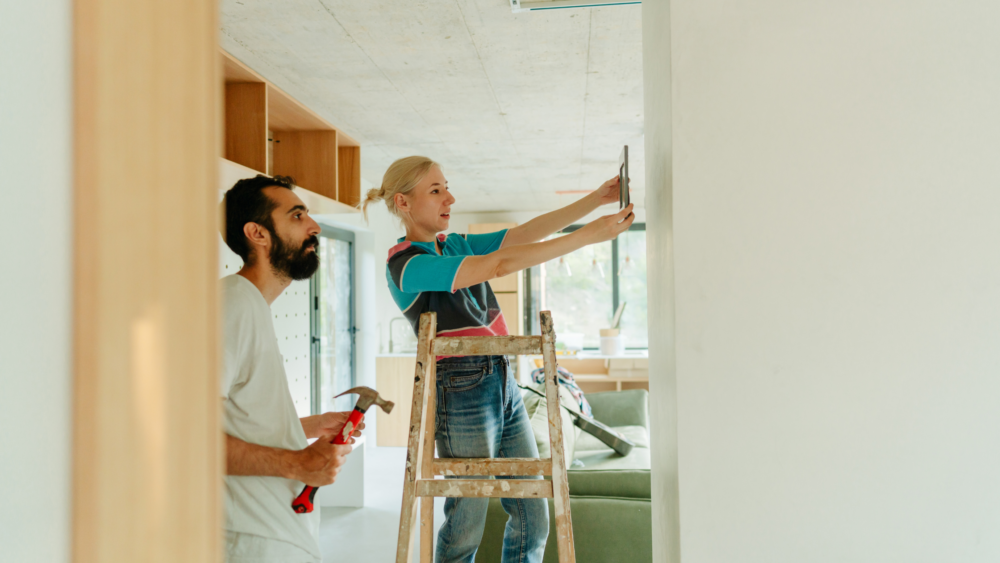Last month, I took a leap—into the abyss of drywall dust and paint swatches known as home renovation. And let me tell you, budgeting for home renovation is like playing financial Tetris with your life savings.
Imagine this: Your master bedroom looks more like a war zone than a retreat. The living room screams 1970s disaster louder than an avocado fridge. You’re ready to dive in but… where do those dollar signs start adding up?
I’ve been there, juggling multiple estimates while the price tag on my dream kitchen danced in my head. So buckle up! By sticking around here, you’ll snag some top-notch strategies to make sure your hard-earned cash is spent wisely—and that unforeseen issues don’t sink your ship.
Creating a Detailed Plan for Your Renovation Project
A clear vision isn’t just some new-age mantra—it’s key when tackling a renovation project. A detailed plan? That’s where the magic happens. Think floor plans sketched out clearer than Picasso’s doodles and every single item—from light fixtures down to drop cloths—all lined up like soldiers ready for battle (against dust). Trust me; creating such precision will make sticking within that elusive ‘project budget’ more super easy than caped crusader stuff.
Having a clear plan and floor layout is essential to making your home renovation dreams come true, so it’s important to create one for the best results. A detailed plan and floor plan become your blueprint for success. They’re like GPS directions that help steer clear of costly detours on the road to renovation bliss.
Steps for Making a Detailed Home Renovation Budget
A budget that’s as tight as Fort Knox might not sound thrilling, but trust me, knowing what you can spend before swinging that sledgehammer will save plenty of headaches later on. It all starts with getting cozy with numbers—specifically square footage because costs often boil down to dollars per foot in the remodeling project game.
To craft this financial masterpiece, begin by mapping out every nook and cranny of your remodel space using good old graph paper or one of those nifty digital floor planning tools online. This isn’t just busy work; it’s how pros ensure they don’t buy too much—or worse—not enough materials (hello unexpected shipping costs.). With each inch planned and accounted for, you get real power over the price tag attached to your dream design.
Next up: creating a project plan so detailed it would make an engineer blush. Lay out everything from demolition day snacks (because who doesn’t love snacking?) to where drop cloths will lay during painting time—a crucial step if ‘ruined floors’ aren’t part of your decor theme. Now take this list and assign an average cost based on estimates gathered from reputable sources including HomeAdvisor which offers valuable insights into typical expenses faced during various types of renovations projects—from updating kitchen appliances in foodie-worthy kitchens to turning master bedrooms into luxurious retreats.
The Floor Plan’s Role in Controlling Costs
You know what they say about assumptions—they’re like poorly installed light fixtures: eventually something’s going wrong. To avoid falling victim to surprises that leave wallets weeping uncontrollably while looking at credit card statements after purchasing high-end marble tiles ‘just because’, let’s talk specifics about controlling renovation costs through effective use of floor plans.
A clear vision backed by precise measurements gives contractors less wiggle room when bidding on jobs thus helping keep project costs grounded firmly within reality—which happens also be where most people live unless their last name is Bezos or Musk. So whether renovating single rooms or tackling multiple spaces simultaneously do yourself favor: whip out measuring tape sooner rather than later.
Understanding the Basics of Budgeting for Home Renovation
Talking dollars and cents, home renovation can be a financial whirlwind. Knowing your budget before you swing that sledgehammer is like having a map in the wild world of remodeling.
How much is it to remodel a house?
If we’re throwing out numbers, let’s get real: On average, homeowners are spending about $49,979 to spruce up their spaces. But hey, it’s not one-size-fits-all—costs can shimmy between $10 and an eye-watering $150 per square foot depending on how fancy or frugal you wanna go. Picture this: You want to turn your kitchen from sad to stunning? The price tag could hit an average of $26,290. And if you think bathrooms are any cheaper—think again; they typically cost around $11,480 on average.
We all know that HomeAdvisor is our best bud when it comes down to nailing those specific figures for each room makeover. They’ve got cost estimates that’ll keep your project stays as predictable as possible because nobody likes ugly surprises with zero commas in their bank account.
Estimating and Managing Renovation Costs
If you’ve ever tackled a home renovation, you know the drill: one minute, your kitchen is stuck in the ’90s, and then bam. You’re knee-deep in swatches and samples. But before visions of shiny new faucets dance through your head, let’s talk turkey—budgeting for those big changes.
Labor Costs: The Invisible Workforce Behind Your Dream Home
First up on our budget list are labor costs. While we all love a good DIY project, some tasks need that professional touch. Think electricians weaving their magic behind walls or plumbers playing Tetris with pipes under your sink. They’re essential to making sure everything runs smoothly (and safely). So when planning financially for these invisible heroes, remember they typically account for about 20-35% of your total budget.
A realistic budget isn’t just a number pulled out of thin air; it’s crafted from detailed cost estimates which include paying people fairly for their skilled work.
Navigating Additional Costs Like an Expert Treasurer
Now let’s chat about additional costs because trust me—they will pop up like uninvited guests at a barbecue. Shipping costs can sneak into the mix if those Italian tiles aren’t coming from down the street but rather across an ocean. Or maybe mid-renovation you realize those drop cloths won’t cut it alone—you’ll need extra to protect that newly installed carpet too.
To keep things from spiraling faster than a Pinterest fail meme, add about 10-15% wiggle room on top of estimated costs as part of managing money wisely during renovations.
The Artful Dodger: Sidestepping Unexpected Expenses
Last but definitely not least are unexpected expenses—and boy do they love showing up unannounced. It might be finding ancient wiring while updating light fixtures or discovering moisture where no moisture should be during bathroom renovations. Average kitchen revamps run around $26,290 while bathrooms hover near $11,480—but always prepare mentally (and financially) to go higher because surprises happen more often than not.
HomeAdvisor notes this well, suggesting keeping aside an emergency fund so these curveballs don’t knock your entire project off track.
Budget Breakdown:
- Kitchen Renovations – $26k average cost depending on appliances & size
- Bathroom Overhauls – $11k average price. Upgrading your bathroom can be a game-changer for home value and comfort. With an expenditure of eleven thousand dollars, you can get materials and skilled workmanship to make your bathroom look like it’s been completely transformed.
Exploring Financing Options for Your Renovation
Funding dreams isn’t always about paying cash while picturing Scrooge McDuck diving into coins—that’s why understanding financing options is vital. Maybe borrowing money through equity loans sounds scarier than haunted houses but hear me out—it might be worth considering along with personal loans or even cash-out refinance options if need be.
Figure Out Financing Before You Build a Remodeling Budget
Funding your renovation dream can be as creative as the project itself. Securing financing beforehand isn’t just smart; it’s critical. Why? Because nothing halts progress like an empty wallet halfway through transforming your kitchen into a culinary paradise.
You’ve got options galore when it comes to borrowing money. A popular choice is pulling equity out of your abode with an equity loan or cash-out refinance. It’s like convincing your house to lend you some dough because you’re making improvements—it gets it.
If those walls could talk, they’d probably suggest visiting HomeZada for insights on how to finance remodels without relying on equity. But if there’s no equity under the roof—or if touching it feels too much like raiding Junior’s college fund—personal loans are another avenue worth strolling down.
The Skinny on Equity Loans and Cash-Out Refinances
Digging into home value through an equity loan can be enticing; think lower interest rates and potential tax deductions (though chatting with a tax pro is always wise). On flip side, risking the nest for granite countertops has its drawbacks—you don’t want financial woes disrupting Sunday pancake mornings in that new kitchen.
Cash-out refinances have their allure too; swapping old mortgages for new ones while pocketing extra cash sounds great. However—and here’s where things get spicy—if mortgage rates are up since buying time, prepare yourself (and perhaps clutch something comforting) because costs might follow suit.
Borrow Without Bricks: Considering Personal Loans
No collateral needed means personal loans won’t put living spaces at stake—which sounds pretty sweet—but beware higher interest rates than secured buddies mentioned earlier. These unsecured debts are based solely on creditworthiness so buff up those scores before knocking lenders’ doors.
When you’re hunting for a personal loan, it pays to be thorough. That’s where NerdWallet comes in handy—they do the heavy lifting by comparing various options to help you pinpoint the perfect match for your financial needs. It’s like finding Cinderella’s slipper without worrying about shattering glass. Check out their comparisons and get closer to securing that just-right loan.
Hiring and Working with Contractors
When it comes to home improvement projects, the right contractor can make or break your renovation dreams. Sure, you might fancy yourself a weekend warrior of sorts, but let’s face it – for most of us, installing kitchen appliances is as foreign as decoding hieroglyphics.
Request Bids From Multiple Contractors
You wouldn’t buy the first car you test drive without checking out a few more options, would you? Same goes for contractors. It’s smart to get bids from multiple pros before deciding who’ll take on your project. This doesn’t just help ensure quality work; it also gets you competitive prices that respect your budget requirements like an old friend.
To give you an idea about numbers: while average cost estimates swing widely depending on what planet of remodeling we’re talking about (a light fixture vs. master bedroom overhaul), having several quotes gives a clearer vision of expected costs and helps keep those financial surprises at bay.
Check References Like Sherlock Holmes
No detective hat needed here. But do channel your inner sleuth when digging into potential contractors’ pasts. Check references like they hold the key to El Dorado because sometimes…they do. Previous clients will tell tales—good or bad—that paint pictures no glossy brochure could ever match.
This step is super easy but so important; think ‘mission-critical’. By doing this due diligence early on, even if there’s an extra shipping cost involved in getting local pros from another zip code over – it could be worth every penny avoiding future headaches.
Understanding Your Contractor’s Bid With X-Ray Vision
If only we had x-ray glasses to see through any hidden details in a bid… Until then, knowing how to read one properly will have to suffice. When reviewing proposals understand not just the price tag attached but also what exactly each item entails — materials used (hello drop cloths.), labor costs baked into cookies that won’t crumble under pressure etcetera etcetera…
An individual project may vary significantly in terms of complexity and therefore cost depending upon myriad factors such as material choices including HomeAdvisor suggests keeping track all these variables using their comprehensive guide Cost to Remodel Multiple Rooms.
Dealing with Unforeseen Issues During Construction
We rely on our knowledge and ingenuity to confront any unforeseen issues that may arise during the remodeling process, guaranteeing a successful transition of your area. You can trust us to handle any curveballs your renovation project throws our way, ensuring a smooth and successful transformation of your space.
FAQs in Relation to Budgeting for Home Renovation
What is a realistic budget for home renovation?
A solid budget depends on the job’s size and your pad’s value; aim to spend no more than 10-15% of your home’s worth.
How do I make a budget for a house renovation?
Dig into costs, tally up materials, labor, permits, then add 20% extra for those just-in-case moments. Plan with precision.
Is $100 000 enough to renovate a house?
Totally depends on what you’re tackling. A full gut might stretch that dough thin but sprucing up rooms? Should cover it.
What is the 30 percent rule for renovations?
This rule says keep reno costs under 30% of your property’s current market value to stay savvy with spending.
Conclusion
Mastering budgeting for home renovation isn’t just smart; it’s essential. Remember, a realistic plan is your blueprint to success. Know those average costs and nail down specifics—square footage matters.
Comparing bids? Do that homework. Check references like a detective because every contractor has a story—and you want the best on your bookshelf.
Financing can be friend or foe. Weigh options carefully; borrowing money needs thought as deep as any foundation you might lay.
Saving here, splurging there—it’s all part of the dance floor of decision-making in renovations. Keep that contingency fund close: surprises are only fun at parties, not during projects.
Your takeaways should be hefty but clear-cut: Plan meticulously, spend wisely, prepare thoroughly—then watch your dream space take shape without becoming a financial nightmare.





